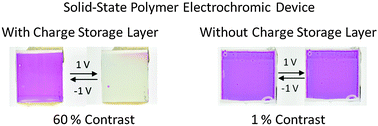Out of sight but not out of mind: the role of counter electrodes in polymer-based solid-state electrochromic devices†
Abstract
Throughout the literature, a variety of counter electrode materials have been used in conjugated polymer-based electrochromic devices (ECDs) without a comparative understanding of their effects on the electrochromic properties of the device. In this study, we show that poor ECD performance, often attributed to electrochromic polymer (ECP) stability, is in fact largely due to an inappropriate choice of counter electrode. We have compared a set of counter electrode materials used in the ECD literature in magenta-to-clear and black-to-clear devices and evaluated how they affect the device parameters including contrast, switching time, stability, and voltage requirements. We demonstrate that through the appropriate choice of counter electrode material (i) the operating voltage can be lowered, (ii) no additional equilibration/break-in time is required, and (iii) the contrast and switching times of the ECP is maintained when incorporated into a device. Furthermore, we show that even unencapsulated ECDs with ECP-Magenta as the vibrantly colored material assembled and operated under ambient conditions can withstand over 10 000 switches without compromising contrast or switching time.


 Please wait while we load your content...
Please wait while we load your content...